Welcome to
the Realm of Gherkins!
Gherkins
The Best Gherkins for the World
At Bnazrum, our gherkins are meticulously graded based on their count, indicating the number of fruits per kilogram. The principle of ‘higher count, higher value’ guides our grading system. Commonly used grades include: 300/450, 150/300, 120/150, 80/150, 80/120, 60/80, 30/60, 30/40, 20/30, 10/20, and 5/10.
Experts suggest that the perfect gherkin should boast a length to diameter ratio of 3:1, ideally measuring between two to four inches in length. In North America, a flawless gherkin typically exhibits seven warts per square inch across its outer surface, while in Europe, gherkins without any warts are preferred.
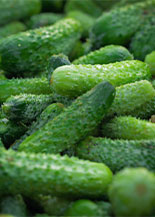
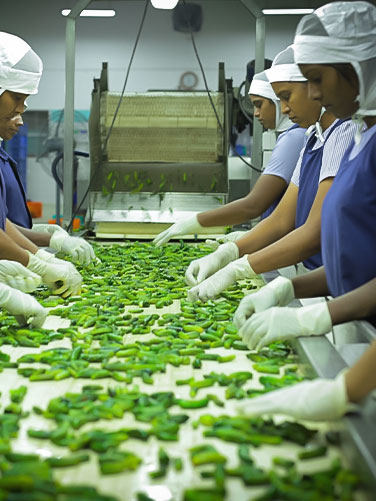
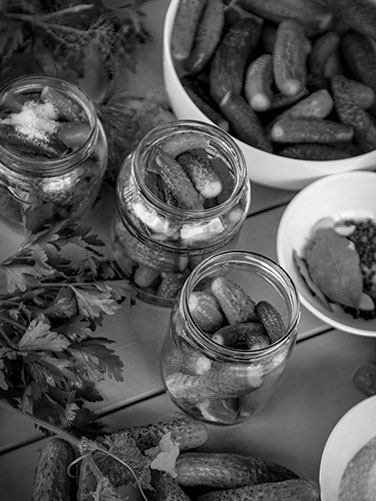
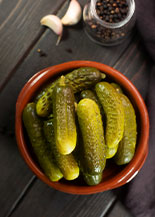
Gherkins
Origins and History
The term “gherkin” possibly derives from the Swedish word “gurka” or the German word “gurke,” both meaning “cucumber.” Gherkin refers to cucumbers pickled or preserved in brine or vinegar. It is the fruit of the cucumis sativus plant from the cucurbit family. There are two varieties of cucumber: those with smooth skin and those with spiny skin, with only the latter being used for gherkins. Gherkins are a type of cucurbitaceous vegetable crop with a 90-day growth period. Their young fruits are harvested and pickled immediately in brine, natural vinegar, or acetic acid.
While gherkins originated in India, the earliest recorded mention dates back to Mesopotamia. It is believed to be the oldest pickle in recorded history, enjoyed by Mesopotamians over four millennia ago. Cleopatra favored pickles, believing they enhanced her beauty. Roman soldiers and Napoleon’s troops were supplied with pickles as part of their rations. Gherkins were considered a sacred food by the Yaskxia people of Russia.
The term “pickled gherkin” appears in English in the 17th century. An advertisement in the Virginia Gazette of 1792 introduced gherkins to the American public. It quickly became a staple in American cuisine, known simply as “the pickle” within a century. During World War II, 40% of all pickles manufactured in the US were reserved for soldiers as a cherished delicacy, providing a taste of home on the battlefield. Gherkin pickles in glass jars became a commercial product in France in the 1820s.
Gherkins
Origins and History
The term “gherkin” possibly derives from the Swedish word “gurka” or the German word “gurke,” both meaning “cucumber.” Gherkin refers to cucumbers pickled or preserved in brine or vinegar. It is the fruit of the cucumis sativus plant from the cucurbit family. There are two varieties of cucumber: those with smooth skin and those with spiny skin, with only the latter being used for gherkins. Gherkins are a type of cucurbitaceous vegetable crop with a 90-day growth period. Their young fruits are harvested and pickled immediately in brine, natural vinegar, or acetic acid.
While gherkins originated in India, the earliest recorded mention dates back to Mesopotamia. It is believed to be the oldest pickle in recorded history, enjoyed by Mesopotamians over four millennia ago. Cleopatra favored pickles, believing they enhanced her beauty. Roman soldiers and Napoleon’s troops were supplied with pickles as part of their rations. Gherkins were considered a sacred food by the Yaskxia people of Russia.
The term “pickled gherkin” appears in English in the 17th century. An advertisement in the Virginia Gazette of 1792 introduced gherkins to the American public. It quickly became a staple in American cuisine, known simply as “the pickle” within a century. During World War II, 40% of all pickles manufactured in the US were reserved for soldiers as a cherished delicacy, providing a taste of home on the battlefield. Gherkin pickles in glass jars became a commercial product in France in the 1820s.


Gherkins
Global Production of Gherkin
The worldwide production of gherkins is estimated at approximately two and a half million metric tons annually. The United States accounts for 40% of this production but relies on imports due to its consumption representing half of the total global production. With a demand of 100,000 metric tons, Russia emerges as a significant potential market for the Indian gherkin industry. Currently, India exports 100,000 metric tons to various nations, including Russia, generating an income of around Rs. 3 billion. This figure is projected to increase to Rs. 5 billion within the next two years, driven by a steady rise in export quantity.
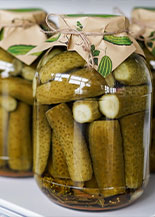
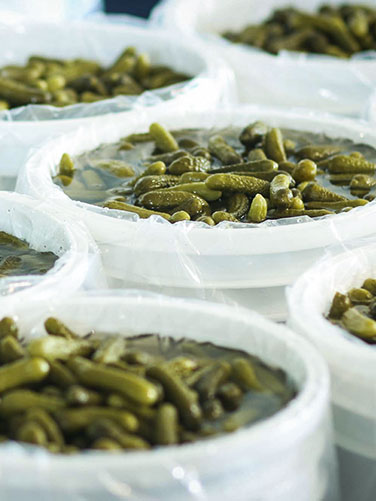

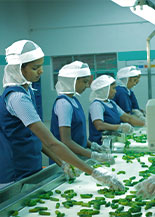
Gherkins
R & D Efforts at Bnazrum
The Bnazrum team oversees agricultural operations, engages with farmers, participates in harvesting, and examines transportation and packing processes. This involvement aids management in identifying productivity obstacles and bottlenecks. Detailed reports are forwarded to the R&D department, which conducts thorough analyses and proposes remedial measures. Preparing pickles to consumer specifications requires extensive groundwork to refine methods. The Hazard Analysis and Critical Control Points (HACCP) system is implemented to trace product quality at critical control points. Consumer and importer specifications dictate product grades, packing mediums, pickle ingredients, and other details.
Gherkins
R & D Efforts at Bnazrum
The Bnazrum team oversees agricultural operations, engages with farmers, participates in harvesting, and examines transportation and packing processes. This involvement aids management in identifying productivity obstacles and bottlenecks. Detailed reports are forwarded to the R&D department, which conducts thorough analyses and proposes remedial measures. Preparing pickles to consumer specifications requires extensive groundwork to refine methods. The Hazard Analysis and Critical Control Points (HACCP) system is implemented to trace product quality at critical control points. Consumer and importer specifications dictate product grades, packing mediums, pickle ingredients, and other details.


Locations
Bnazrum Agro Exports Pvt. Ltd.
Sirumalai Road, Reddiapatti Post
Dindugul - 624 006
Tamil Nadu, India

